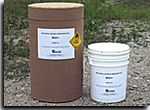Our Goal: A Clean Environment
Product Overview
Biological Oxygen Compound+Plus™, (BOC+™)
BioRenova developed a mixture of ingredients known as
Biological Oxygen Compound+Plus™, (BOC+™),
which is a
two (2)-part, cost effective, food
grade formulation with Calcium Peroxide that contains approximately 18% oxygen by weight
(more than our competitors), and produces a slow and sustained release of molecular oxygen
for up to one year depending on site conditions, when in contact with soil moisture or groundwater.
In addition to greater oxygen-releasing capabilities,
unlike it's competitors,
BOC+ also contains food grade macro and micronutrients, pH adjustment, a blend of biodegradable surfactants, carbon sources and other ingredients that promote and support beneficial microbial growth and enzymatic diversity.
The soil groundwater matrix normally does not contain a sufficient
amount of nutrients to support optimum biotransformation. It is for
this reason; unlike our competitors, BOC+
also contains a diverse nutrient supplement to increase the biomass.
The degradation rate is proportional to the amount of biomass, more
biomass, and faster degradation of contaminants.
Respirometer studies have conclusively proven that in order to have optimum degradation, it is also necessary to have the contaminants available for microbial activity, a blend of biodegradable surfactants, minerals, vitamins, pH buffering and other adjusted site conditions
greatly increase the rapid mineralization of hydrocarbons.
Dehalogenation Compound+Plus (DHC+),
In the late 1980s Environmental Laboratories, Inc., started performing experiments with electron acceptors and donors,
carbon energy sources, surfactants, yeast extracts, macro and micro
nutrients, etc. for anaerobic bioremediation of
chlorinated solvents. Efforts were directed at Tetrachloroethlyene and their degradation products.
Inland Consultants,
Inc. and Inland Environmental, Inc. assisted in the experimentation and the securing of a United States and Japanese patent for a mixture of electron acceptors, donors, and proprietary ingredients
for a product known as
DHC+, which promotes reductive de-chlorination.
DH+ is
effective in degrading a wide range of halogenated compounds such
as: carbon tetrachloride, chloroform, methylene chloride, certain
chlorinated pesticides/herbicides, dyes perchlorate, nitrate,
nitroaromatic explosives, dyes CFCs, some metals and radionuclides
The use of DHC+ for reductive
dechlorination did not result in the formation of large amounts of vinyl chloride (VC) and at some
sites, VC did not accumulate, but was simultaneously degraded as it formed. Thus, there was no accumulation of VC as is common in reductive
dechlorination of chlorinated solvents with other methods of remediation.
Chloroclean Inoculum,
Experiments conducted by Environmental Laboratories Inc. revealed that anaerobic bioremediation of halogenated compounds could be enhanced with the use of sludge from a sewage plant, operating an anaerobic digestion system. This sludge was pathogen free, contained a large consortium of microbes, and contained species of microbes known to facilitate complete
dechlorination from DCE to ethene.
The sludge was used to bioaugment
Dehalogenation Compound+Plus as an Inoculum for the
remediation of a solvent dispensing and storage facility, Technical
Products Company, Inc., located in
Chicago, Illinois, which had been in operation since 1939. The
total extractable organic halides (EOX) were extremely high, PCE was
at 5,226 ppm in some locations. The site was remediated in 18
months to residential promulgated standards and received a No
Further Remediation letter from the Illinois Environmental
Protection Agency. Cultures were extracted from the site and
further enriched to increase its ability to degrade halogenated
compounds at those sites that are deficient in a large consortium of
microbes containing Dehalogenation species.

![]()
